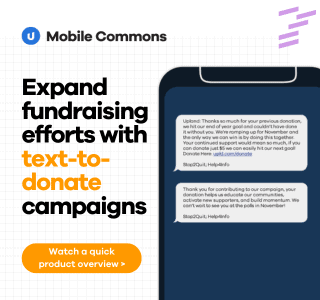 As recently as three years ago, reputable sources wondered if text messaging — after a two-decade ramp-up — had peaked in popularity. Those predictions turned out to be starkly premature, as 97 percent of American smartphone owners text at least once a day, with many of them saying they had done so within the past hour when surveyed by Pew Research Center at the end of 2014.
As recently as three years ago, reputable sources wondered if text messaging — after a two-decade ramp-up — had peaked in popularity. Those predictions turned out to be starkly premature, as 97 percent of American smartphone owners text at least once a day, with many of them saying they had done so within the past hour when surveyed by Pew Research Center at the end of 2014.
So, what has been propping up the popularity of text messaging? A look back at developments during 2015 reveals the emergence of SMS-based features and services — built on existing businesses and preferences — that will continue to drive text messaging as a dominant force in the coming year and beyond.
When text messaging complements existing offerings
 Gone is a San Francisco-based startup backed by $1 million in venture funding from the likes of MasterCard and Silicon Valley Bank. The business works on the elegantly simple concept of helping people sell any unwanted items of value. At the core is a mobile app that allows prospective sellers to input information, receive a quote, and schedule a runner to haul away the item, reports TechCrunch.
Gone is a San Francisco-based startup backed by $1 million in venture funding from the likes of MasterCard and Silicon Valley Bank. The business works on the elegantly simple concept of helping people sell any unwanted items of value. At the core is a mobile app that allows prospective sellers to input information, receive a quote, and schedule a runner to haul away the item, reports TechCrunch.
Recently, Gone started offering a phone number to connect with an assistant whose job is to walk sellers through the process. “Send a text to this number to start selling your stuff,” states the header on Gone’s SMS website. Sellers can also enter their mobile number on the website to initiate a text session. The SMS capability is available nationwide.
Likewise, services such as banking tool Digit and a digital personal assistant called Cloe use text messaging as their primary interface to communicate with customers.
Digit is set up to help users save money by establishing a new savings account linked to an existing bank account. It tracks spending habits, determines an affordable savings amount based on those habits, and then prompts the user for permission to deposit the amount in the new account. The user merely needs to respond with a “yes” or “no” text message. It’s most popular with users in their 20s, a generation highly attuned to SMS.
Cloe works in the same fashion as Siri, the voice recognition technology built into Apple’s iPhones. Cloe provides personalized recommendations based on the user’s preferences, location and other people’s reviews. The defining difference, according to developer Chase Hildebrand, is that the user communicates with Cloe using text messages, rather than through vocal commands. He claims that Chloe’s SMS service tops Siri in terms of being faster, more efficient and more “intelligent.”
New and interesting uses of SMS will continue to fuel its popularity
Ubiquity and ease of use are huge advantages for SMS as compared to other types of mobile marketing. In fact, tech industry beacon Wired called text messaging “the future of user interface design” in a June 2015 feature.
The article cites the following reasons why SMS works ideally as the user interface of choice:
- Its most basic function, chat, opens up the scope of consumer interaction, as opposed to an app built on presenting a finite set of options.
- It eliminates the need for redundant apps. Texting enables users to complete multiple tasks from one place, while retaining full functionality and without requiring extra steps.
- It’s familiar and efficient. Interaction rules vary from app to app. In contrast, text-based interactions require no learning curve.
Concurrent with the resurgent recognition of SMS as a universal platform for connecting with people, other tech developers are working to make text messaging even better. Cola, another San Francisco startup, has built what’s described as an operating system for text messaging.
Cola’s Messaging OS launched in beta form in November 2015. As reported in USA Today, its goal is “to give people complete access to smartphone functions while they are in the middle of a text conversation, without them having to leave that conversation.” It does so through interactive “bubbles” — pop-up areas that appear within a messaging thread. A user might bring his/her calendar, location and checklist seamlessly into the SMS session, for example.
Where text messaging is headed from here
Jed Alpert, an authority on mobile communications strategy and author of the book The Mobile Marketing Revolution: How Your Brand Can Have a One-to-One Conversation with Everyone, sees a bright pathway for text messaging in 2016.
“It’s the most pervasive form of communication there is,” explains Alpert, SVP and General Manager of Upland Mobile Messaging by Upland. “All kinds of ongoing communications that were previously done in a hodgepodge way of email, phone calls and such can now be centralized around text messaging.”
 Alpert says Upland Mobile Messaging is taking text messaging’s near-universal acceptance — “multiple orders of magnitude more likely to engage someone rather than an app” — and fitting it into wide-ranging business processes such as higher education, government services, healthcare, even waste removal/recycling. Industry statistics bear out his enthusiasm. For instance, a poll conducted by the International Customer Management Institute showed that 79 percent of companies believe customers want SMS/text support.
Alpert says Upland Mobile Messaging is taking text messaging’s near-universal acceptance — “multiple orders of magnitude more likely to engage someone rather than an app” — and fitting it into wide-ranging business processes such as higher education, government services, healthcare, even waste removal/recycling. Industry statistics bear out his enthusiasm. For instance, a poll conducted by the International Customer Management Institute showed that 79 percent of companies believe customers want SMS/text support.
“The advances in technology are mostly integrating text messaging into all other aspects of technology,” Alpert observes. “What’s new is bringing power to whatever it is you want to get done. It’s never text messaging for the sake of text messaging — it’s text messaging for the outcome that your business or organization desires.”
For more information on integrating text messaging into your business, contact us.

